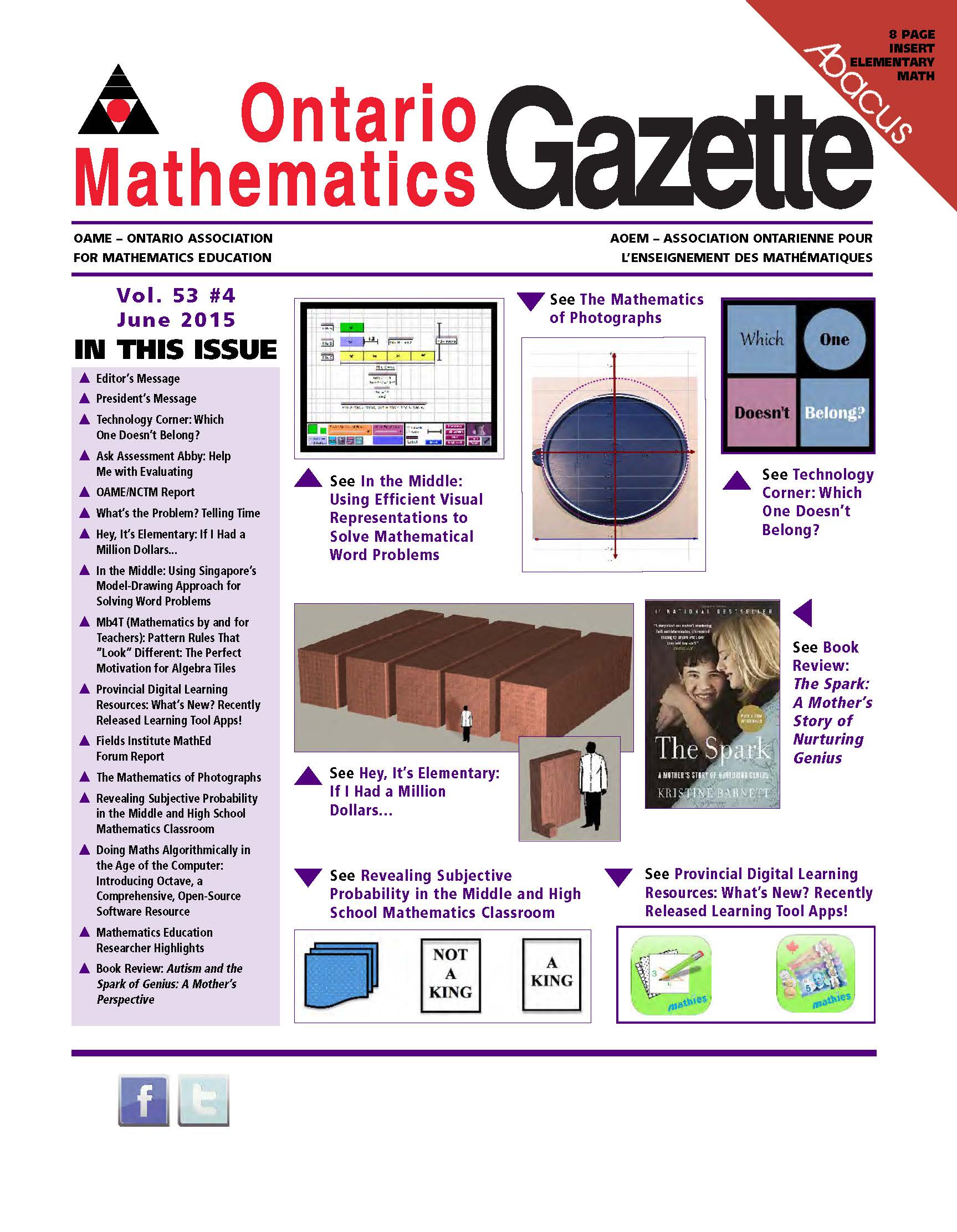 OAME Gazette Volume 53 Number 4 released and includes three new articles and ten regular columns.
OAME Gazette Volume 53 Number 4 released and includes three new articles and ten regular columns.
In their co-authored work, Revealing Subjective Probability in the Middle and High School Mathematics Classroom, Egan Chernoff and Jack Chernoff contrast subjective probability with classical and frequentist probability foci. Using a deck of standard playing cards, they further share an innovative approach to the teaching and learning of a central tenet of subjective probability, for recommended use in the middle or high school mathematics classroom.
In his article entitled The Mathematics of Photographs, Tim Sibbald builds upon his previous work (Mathematics of a Hill, 2014) and makes the case that sometimes modelling a physical object, seen in terms of the photographic image, can be useful for identifying patterns. Through the use of a number of intriguing geometric diagrams and photographs with grid/intercept overlays, Sibbald models his stated goal of providing a workable sense of how the taking of a photograph transforms the geometry of a physical object.
Roger Herz-Fischler, in his article entitled Doing Maths Algorithmically in the Age of the Computer, introduces and advocates for the use of a comprehensive, open-source software known as Octave. He also makes the case for introducing high school students to an algorithmic approach to solving certain complex problems; and points out the perceived dichotomy existing in the Ontario Mathematics and Computer Science curricula. Through the analysis of a familiar “birthday problem,” Herz-Fischler describes the utility of the software Octave, and further offers a link to a free introductory resource.
Regular columns include the following highlights: OAME President, Paul Alves (President’s Message) reflects fondly on his term as President; Assessment Abby (eponymous) answers a submitted question regarding the evaluation of curriculum expectations; Mary Bourassa (Technology Corner) highlights a new website entitled, Which One Doesn’t Belong, and created by Christopher Danielson; Mirela Ciobanu (In the Middle) looks at Singapore’s model-drawing approach for solving word problems using text, pictorial, and symbolic representations; Greg Clarke, Agnes Grafton, Ross Isenegger, and Markus Wolski (Provincial Digital Learning Resources) present and extol their two new web/mobile learning tool apps, Money and Notepad; Lynda Colgan (Hey, It’s Elementary) tackles large numbers such as billions, trillions, quadrillions, and…googolplexes [see also Richard Schwartz’s fantastic new book/website on a similar theme, Really Big Numbers (AMS, 2014)]; Stewart Craven (Fields Institute MathEd Forum Report) provides speaker highlights from the Saturday March 27th meeting; Shawn Godin (What’s the Problem?) poses a problem regarding telling time with two given hourglasses; Ann Kajander (MB4T) discusses student explorations of pattern rules using virtual algebra tiles; Todd Romiens (OAME/NCTM Report) discusses the teaching of mathematics to preschoolers; and, as usual, this issue also features the rich contribution of ideas for elementary math teaching as found in the Abacus insert, co-edited by Mary Lou Kestell and Kathy Kubota-Zarivnij, and focusing here on Spatial Reasoning via Patterning and Algebra and Data Management and Probability strand problems.
Volume 53 Issue 4 also includes several special features: (i) a review by Tim Sibbald of Barnett’s inspiring documentary tale, The Spark: A Mother’s Story of Nurturing Genius, in which she recounts her autistic son’s incredible and ongoing journey through life and learning; (ii) several further entries of Ontario mathematics education researchers and their respective projects; and, (iii) selected excerpts of Canadian researcher contributions to Lerman’s new Encyclopedia of Mathematics Education (2014).
